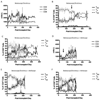Belatacept and sirolimus prolong nonhuman primate renal allograft survival without a requirement for memory T cell depletion
- PMID: 23311611
- PMCID: PMC3558532
- DOI: 10.1111/j.1600-6143.2012.04342.x
Belatacept and sirolimus prolong nonhuman primate renal allograft survival without a requirement for memory T cell depletion
Abstract
Belatacept is an inhibitor of CD28/B7 costimulation that is clinically indicated as a calcineurin inhibitor (CNI) alternative in combination with mycophenolate mofetil and steroids after renal transplantation. We sought to develop a clinically translatable, nonlymphocyte depleting, belatacept-based regimen that could obviate the need for both CNIs and steroids. Thus, based on murine data showing synergy between costimulation blockade and mTOR inhibition, we studied rhesus monkeys undergoing MHC-mismatched renal allotransplants treated with belatacept and the mTOR inhibitor, sirolimus. To extend prior work on costimulation blockade-resistant rejection, some animals also received CD2 blockade with alefacept (LFA3-Ig). Belatacept and sirolimus therapy successfully prevented rejection in all animals. Tolerance was not induced, as animals rejected after withdrawal of therapy. The regimen did not deplete T cells. Alefecept did not add a survival benefit to the optimized belatacept and sirolimus regimen, despite causing an intended depletion of memory T cells, and caused a marked reduction in regulatory T cells. Furthermore, alefacept-treated animals had a significantly increased incidence of CMV reactivation, suggesting that this combination overly compromised protective immunity. These data support belatacept and sirolimus as a clinically translatable, nondepleting, CNI-free, steroid-sparing immunomodulatory regimen that promotes sustained rejection-free allograft survival after renal transplantation.
© Copyright 2013 The American Society of Transplantation and the American Society of Transplant Surgeons.
Conflict of interest statement
The authors of this manuscript have no conflicts of interest to disclose as described by the American Journal of Transplantation.
Figures





Similar articles
-
Belatacept and sirolimus prolong nonhuman primate islet allograft survival: adverse consequences of concomitant alefacept therapy.Am J Transplant. 2013 Feb;13(2):312-9. doi: 10.1111/j.1600-6143.2012.04341.x. Epub 2012 Dec 27. Am J Transplant. 2013. PMID: 23279640 Free PMC article.
-
Corticosteroids and methotrexate as adjuvants to costimulation blockade in non-human primate renal transplantation.Clin Transplant. 2019 Jun;33(6):e13568. doi: 10.1111/ctr.13568. Epub 2019 May 7. Clin Transplant. 2019. PMID: 31006146 Free PMC article.
-
Alefacept promotes co-stimulation blockade based allograft survival in nonhuman primates.Nat Med. 2009 Jul;15(7):746-9. doi: 10.1038/nm.1993. Epub 2009 Jul 5. Nat Med. 2009. PMID: 19584865 Free PMC article.
-
Biological agents in kidney transplantation: belatacept is entering the field.Expert Opin Biol Ther. 2010 Oct;10(10):1501-8. doi: 10.1517/14712598.2010.514901. Expert Opin Biol Ther. 2010. PMID: 20726688 Review.
-
Belatacept in kidney transplantation.Curr Opin Organ Transplant. 2012 Dec;17(6):640-7. doi: 10.1097/MOT.0b013e32835a4c0d. Curr Opin Organ Transplant. 2012. PMID: 23044530 Review.
Cited by
-
Targeting co-stimulatory pathways: transplantation and autoimmunity.Nat Rev Nephrol. 2014 Jan;10(1):14-24. doi: 10.1038/nrneph.2013.183. Epub 2013 Oct 8. Nat Rev Nephrol. 2014. PMID: 24100403 Free PMC article. Review.
-
The Role of Costimulation Blockade in Solid Organ and Islet Xenotransplantation.J Immunol Res. 2017;2017:8415205. doi: 10.1155/2017/8415205. Epub 2017 Oct 11. J Immunol Res. 2017. PMID: 29159187 Free PMC article. Review.
-
Belatacept: the challenges with transformational drugs.Transl Androl Urol. 2017 Apr;6(2):341-342. doi: 10.21037/tau.2017.03.07. Transl Androl Urol. 2017. PMID: 28540252 Free PMC article. No abstract available.
-
A pilot trial targeting the ICOS-ICOS-L pathway in nonhuman primate kidney transplantation.Am J Transplant. 2015 Apr;15(4):984-92. doi: 10.1111/ajt.13100. Epub 2015 Feb 20. Am J Transplant. 2015. PMID: 25703015 Free PMC article.
-
Can We Repurpose FDA-Approved Alefacept to Diminish the HIV Reservoir?Immunotherapy (Los Angel). 2015 Dec;1(1):104. doi: 10.4172/imt.1000104. Epub 2015 Nov 30. Immunotherapy (Los Angel). 2015. PMID: 27110598 Free PMC article.
References
-
- Larsen CP, Elwood ET, Alexander DZ, Ritchie SC, Hendrix R, Tucker-Burden C, et al. Long-term acceptance of skin and cardiac allografts after blocking CD40 and CD28 pathways. Nature. 1996;381(6581):434–438. - PubMed
-
- Larsen CP, Pearson TC, Adams AB, Tso P, Shirasugi N, Strobert E, et al. Rational development of LEA29Y (belatacept), a high-affinity variant of CTLA4-Ig with potent immunosuppressive properties. Am J Transplant. 2005;5(3):443–453. - PubMed
-
- Vincenti F, Larsen CP, Alberu J, Bresnahan B, Garcia VD, Kothari J, et al. Three-year outcomes from BENEFIT, a randomized, active-controlled, parallel-group study in adult kidney transplant recipients. Am J Transplant. 2012;12(1):210–217. - PubMed
-
- Pestana JO, Grinyo JM, Vanrenterghem Y, Becker T, Campistol JM, Florman S, et al. Three-year outcomes from BENEFIT-EXT: a phase III study of belatacept versus cyclosporine in recipients of extended criteria donor kidneys. Am J Transplant. 2012;12(3):630–639. - PubMed
Publication types
MeSH terms
Substances
Grants and funding
LinkOut - more resources
Full Text Sources
Other Literature Sources
Medical
Research Materials
Miscellaneous

